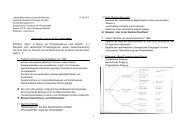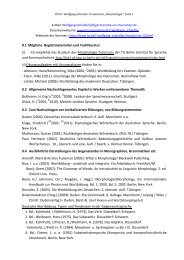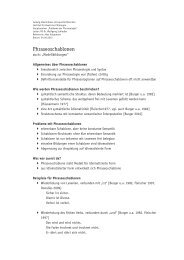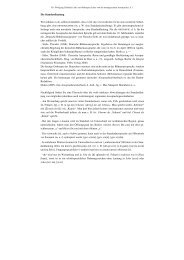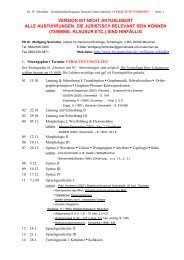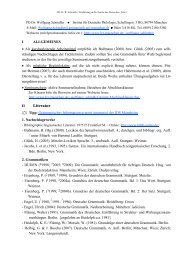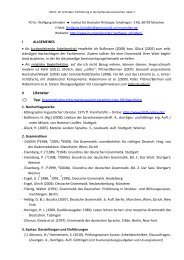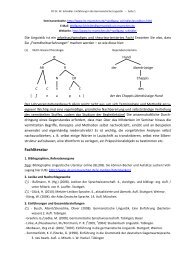Chapter 18 Lexical Functions: Description of Lexical Relations in a ...
Chapter 18 Lexical Functions: Description of Lexical Relations in a ...
Chapter 18 Lexical Functions: Description of Lexical Relations in a ...
You also want an ePaper? Increase the reach of your titles
YUMPU automatically turns print PDFs into web optimized ePapers that Google loves.
—<strong>Chapter</strong> <strong>18</strong>. <strong>Lexical</strong> <strong>Functions</strong>— 74<br />
4. under the vocable to which the given element <strong>of</strong> an LF value belongs.<br />
Let us consider these cases <strong>in</strong> turn.<br />
1. Shared Values <strong>of</strong> <strong>Lexical</strong> <strong>Functions</strong> and Cross-references to a Convenient <strong>Lexical</strong> Unit <strong>of</strong> a Vocable<br />
If the LU L1 <strong>of</strong> the vocable {L} has the same values <strong>of</strong> some LFs as L2, another LU <strong>of</strong> {L}<br />
or <strong>of</strong> a different vocable {L´}, these values are given only under L2, with a cross-reference under<br />
L1: ↑L2, i.e., ‘see L2’. For <strong>in</strong>stance, under ESCAPEN, we f<strong>in</strong>d <strong>in</strong> the LF zone:<br />
LFs S 1Perf, S 1Able 1, S usual<br />
2, S 3, A 1: ↑ESCAPEV,<br />
which means (the values for the LFs S 1Perf, S 1Able 1, S usual<br />
2, S 3 and A 1 for the LU ESCAPEN are<br />
identical to the values for the same LFs for the LU ESCAPEV).<br />
This is a rather straightforward technical generalization.<br />
2. Shared Values <strong>of</strong> <strong>Lexical</strong> <strong>Functions</strong> and the Generic <strong>Lexical</strong> Unit <strong>of</strong> the Semantic Field<br />
LUs belong<strong>in</strong>g to the same semantic field may have the same values for the same LFs. Of<br />
course this is only a tendency, s<strong>in</strong>ce there are numerous exceptions and deviations, 21 yet <strong>in</strong> some<br />
cases this tendency is quite clear. If shared values <strong>of</strong> LFs are semantically determ<strong>in</strong>ed—that is, if<br />
the keywords belong to the same semantic field, the generalization can be achieved without expli-<br />
cit cross-references. It suffices to store all common values <strong>of</strong> LFs supplied with necessary <strong>in</strong>dica-<br />
tions only once—under the generic lexical unit <strong>of</strong> the correspond<strong>in</strong>g semantic field.<br />
The methodology (proposed <strong>in</strong> Mel’čuk & Wanner 1996) runs as follows:<br />
1) Each semantic field is identified by its generic LU—LGENER. For <strong>in</strong>stance, for the field CAR,<br />
TRUCK, BUS, CARAVAN, MOTORBIKE, ... the LGENER is MOTOR VEHICLE; this LGENER appears <strong>in</strong> the<br />
def<strong>in</strong>itions <strong>of</strong> all the LUs <strong>of</strong> the field.<br />
2) The LGENER <strong>of</strong> a semantic field can have, <strong>in</strong> addition to its own ‘private’ entry, another one,<br />
called ‘public’, where the shared elements <strong>of</strong> the values <strong>of</strong> the LFs associated with the <strong>in</strong>divi-<br />
dual members <strong>of</strong> the field are stored. They are not repeated <strong>in</strong> <strong>in</strong>dividual entries, which thus<br />
conta<strong>in</strong> only those LF value elements which are idiosyncratic to particular LUs.<br />
3) When the user needs the value <strong>of</strong> a particular LF f as applied to a particular LU L, he is sup-<br />
posed to look for it <strong>in</strong> the entry <strong>of</strong> L. If, however, the value f(L) is not given <strong>in</strong> L’s entry or if it is<br />
given only partially, it has to be looked up <strong>in</strong> the public entry <strong>of</strong> the LGENER <strong>of</strong> the correspond<strong>in</strong>g<br />
field (LGENER is specified <strong>in</strong> L’s def<strong>in</strong>ition). Thus, there is no need to repeat Real 1 = drive and<br />
Real 2<br />
= ride for every particular name <strong>of</strong> a motor vehicle: both verbs can be <strong>in</strong>dicated only once,<br />
<strong>in</strong> the ‘public’ entry <strong>of</strong> MOTOR VEHICLE. From there, they are <strong>in</strong>herited by all LUs <strong>of</strong> this field.


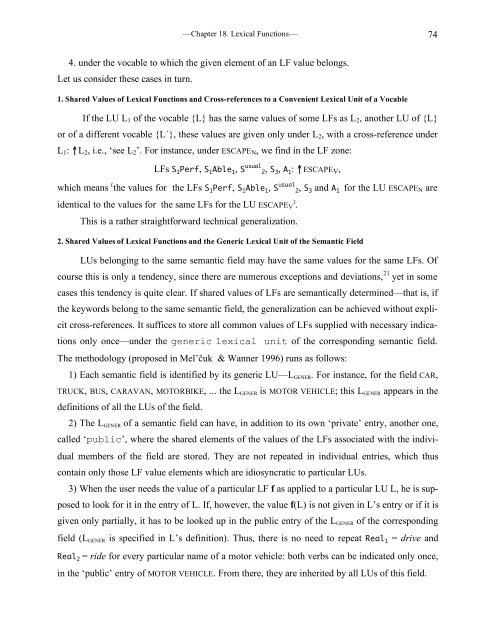
![E-Mail: Wolfgang.Schindler[ätt]germanistik.uni-muenchen.de Web ...](https://img.yumpu.com/51590147/1/184x260/e-mail-wolfgangschindlerattgermanistikuni-muenchende-web-.jpg?quality=85)
